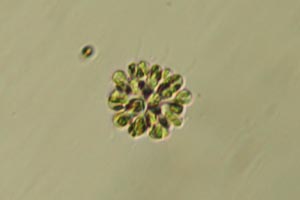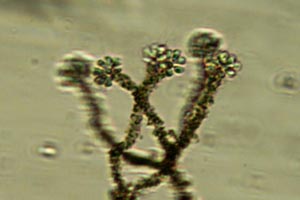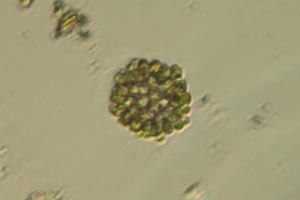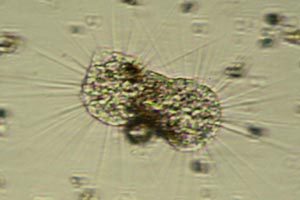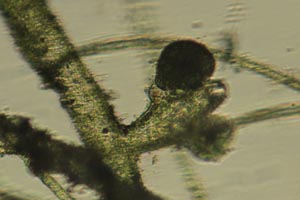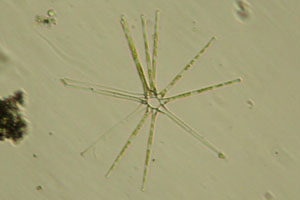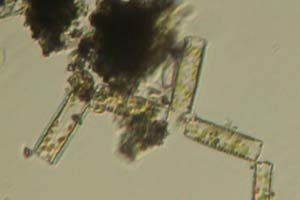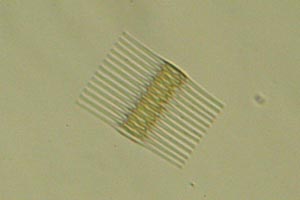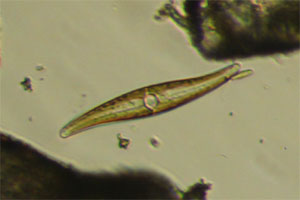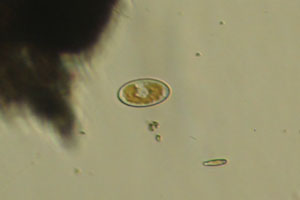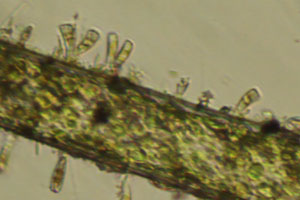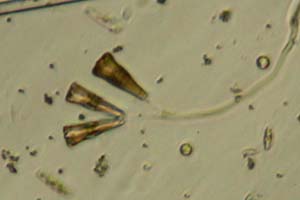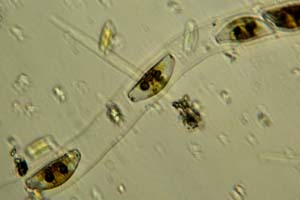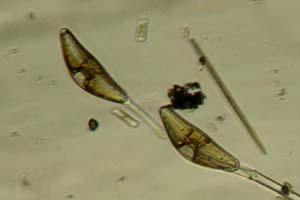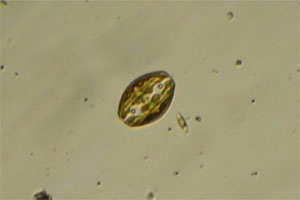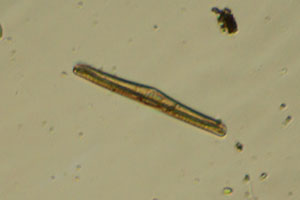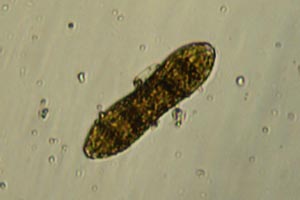Kingdom Chromista, Phylum Ochrophyta
Ochrophyta are united by two main features, although each is found separately in other chromists. The first is having plastids enclosed by an extension of the nuclear membrane. These mostly take the form of golden-brown chloroplasts, but in some are greenish, and some bacterivores have only colourless plastids.
The second is the heterokont structure of flagellate cells, which most produce at some point in their life cycle, for instance as gametes or spores. These have one longer flagellum covered with fine bristles, which act like tiny oars to reverse the current it produces, and usually one shorter flagellum without them.
In other respects this is one of the most variable groups of algae, ranging from single-celled flagellates and amoebae to giant seaweeds with differentiated tissues and cell walls.
Golden algae occur mainly in freshwater. They are mostly small flagellates but also include some non-motile or amoeboid types, and many form a variety of cell colonies, which reproduce by fragmenting so the cells vary in number. Most kinds are photosynthetic, with 1-2 golden chloroplasts in each cell.
Synura
Greek syn, together, oura, tail
Angl. si-NOOR-a
Synura are round or oval colonies that swim with a tumbling motion. The cells are club-shaped and packed close together, each with two chloroplasts but no eyespot.
Mallomonas
Greek mallos, lock of wool, monas, unit
Angl. ma-LOM-o-nas
Mallomonas are free-swimming cells with an oval or tailed shape. They produce clear silicate scales and spines, assembled into a pine cone- or burr-like covering.
Anthophysa
Greek anthos, flower, physis, nature
Angl. an-THOF-i-sa
Anthophysa cells are colourless and form round clusters. These usually occur in colonies anchored by peculiar twisted brown stalks, but may also become detached.
Uroglenopsis
Greek oura, tail, glēnē, eyeball, opsis, appearance
Angl. YOOR-o-gle-NOP-sis
Uroglenopsis are hollow spheres of small cells, each with blunt rather than tapered ends and held together by mucilage. Small colonies are often pale or even appear colourless.
Dinobryon
Greek dinos, whirling, bryon, moss
Angl. dye-NOB-reeon
Dinobryon form free-swimming colonies. Each cell has a clear vase-shaped lorica, which are attached end-to-end in a distinctive branching pattern.
Raphidophytes are a small group of single cells. Most have many green chloroplasts, no eyespot, and leading and trailing flagella in a groove. Some smaller flagellates and the actinophryids have also been suggested as belonging here, all sharing large nuclei with peculiar features of division.
Actinophryids are freshwater amoebae with no plastids or flagella. Instead they are heliozoan-like, with prominent axopodia radiating from a round body. This can also deform to engulf larger prey. The outer cell is filled with vesicles, a few typically protruding out as they collect water for expulsion.
Actinophrys
Greek aktis, ray, ophrys, brow
Angl. AK-ti-NOF-ris
Actinophrys have small outer vesicles and a single central nucleus. They are some of the most common amoebae with axopodia, often found among submerged vegetation.
Yellow-green algae have cell walls and the more common kinds are non-motile. They lack the gold-brown pigment found in most chromist algae, so are coloured more like green algae, but do not have pyrenoids or starch. Most occur in freshwater or soil.
Vaucheria
After Jean Vaucher, 1763-1841
Angl. vaw-SHEER-eea
Vaucheria are filaments with many chloroplasts and nuclei. They are not separated into cells, except in special branches where larger round and smaller flagellate gametes are formed.
Diatoms are a large group found in nearly all aquatic habitats. Each cell has a silicate case divided into two valves, one of which fits over the other like the lid of a box. After dividing, each daughter keeps one valve and grows a new one within it, so one becomes slightly smaller. Size is normally restored with sexual reproduction.
Melosira
Greek mēlon, apple, seira, cord
Angl. MEL-o-SYE-ra
Melosira form straight filaments of rounded to cylindrical cells. The valve ends are not quite square and so leave small gaps, but with cells typically enclosed as pairs or triples.
Pennate diatoms are distinguished by bilateral symmetry and include most common freshwater types. Many of these adhere to form colonies, attaching at the valve faces or corners. Note all the kinds listed here are freshwater, but very similar forms may occur among different genera that are marine.
Asterionella
Greek asterios, star-like
Angl. a-STER-eeo-NEL-a
Asterionella form distinctive stellate colonies where the cells project out like spokes in a wheel, joined by the corners at one tip. This end is slightly wider than the other.
Diatoma
Greek dia, through, tomos, cut
Angl. dye-AT-o-ma
Diatoma have small grooves called costae across valve faces, but no deeper internal walls. They attach either face-to-face or more often by corners, forming zig-zag chains.
Fragilaria
Latin fragilis, fragile
Angl. FRAJ-i-LAIR-eea
Fragilaria form stacks or ribbon-like strands connected by inconspicuous spines. In many the centres of the cells are slightly widened, leaving spaces between the tips.
A large group of pennate diatoms have slits, called raphes, in one or both valves. These are able to secrete mucilage, allowing them to glide along surfaces. In colonies the cells are usually contained within gelatinous tubes or attached by branching stalks.
Nitzschia
After Christian Nitzsch, 1782-1837
Angl. NITCH-eea
Nitzschia usually have raphes hidden on diagonally opposite corners, which are often tilted to give them a rhomboid or inflected shape. There is one chloroplast in each half.
Gyrosigma
Greek gyros, ring, sigma, letter σ or ς
Angl. JYE-ro-SIG-ma
Gyrosigma have a raphe running down the centre of each valve and chloroplasts running along both sides. The ends are curved towards opposite sides, making them slightly s-shaped.
Cocconeis
Greek kokkos, grain, naus or nēes, ship
Angl. KOK-o-NEE-is
Cocconeis are oval with a peculiar C-shaped chloroplast. The top valve is slightly dome-shaped, while the other is flat with a raphe and commonly attaches to other algae or plants.
Rhoicosphenia
Greek roikos, crooked, sphēn, wedge
Angl. ROY-kos-FEE-neea
Rhoicosphenia have wedge-shaped valves, which are angled apart and distinctively curved. They form attachments by pads or stalks at the narrow end.
Gomphonema
Greek gomphos, bolt, nēma, thread
Angl. GOM-fo-NEE-ma
Gomphonema are wedge-shaped with branching stalks. The faces usually have rounded or pointed rather than bulging ends, or at least not on the side where the stalk is formed.
Encyonema
Greek egkyos, pregnant, nēma, thread
Angl. EN-seeo-NEE-ma
Encyonema form strings of cells enclosed in gelatinous tubes. Each cell is curved with the raphe along the middle, and usually one chloroplast with a pyrenoid near the inner edge.
Cymbella
Greek kymbē, bowl or boat
Angl. sim-BEL-a
Cymbella resemble Encyonema but are curved the opposite way, with the pyrenoid near the outside, and are often larger. They occur singly or in colonies with branching stalks.
Amphora
Greek amphoreus, amphora
Angl. AM-for-a
Amphora have crescent-shaped valves but tilted to face the same side of the cell, giving it an elliptical outline with flat ends. This side is sometimes attached to plants or debris.
Rhopalodia
Greek ropalon, club
Angl. ROH-pa-LOH-deea
Rhopalodia also have valves tilted to the same side; these are narrow with turned up ends, while the base is wider and usually bulges in the middle. The raphes are on the outer rims.
Cymatopleura
Greek kyma, wave, pleura, side
Angl. SYE-ma-to-PLOOR-a
Cymatopleura have valves with waves, visible from above as bands. Each face is covered by half of the chloroplast and has a raphe around its margin, which may constrict near the middle.
